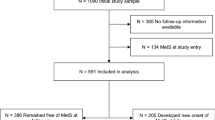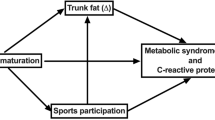Abstract
Objective:
to explore the effect of organized youth sport on metabolic syndrome (MetS) in adulthood.
Design:
Longitudinal study data from the cardiovascular risk in young Finns study.
Subjects:
A total of 1493 males (n=704) and females (n=789) aged 3, 6, 9, 12, 15 and 18 years were randomly selected from five university towns and their rural surroundings in 1980. They were followed up for 21 years. In 2001 they were 24, 27, 30, 33, 36 and 39 years old.
Measurements:
Youth sports participation data (participation in sport-club training and competitions) were assessed in 1980 and 1983 using a self-report questionnaire completed in connection with a medical examination. Participants were divided into athletes and non-athletes at each measurement point, and then classified into four groups: Persistent athlete, Starter, Leaver and Non-athlete. A mean score of youth sport was assessed by calculating the average of four consecutive measurements (1980–1989). MetS risk in 2001 was defined as a categorical variable based on the guidelines of the European Group for the Study of Insulin Resistance (EGIR) and as a continuous MetS-score variable by summing the z-scores of individual metabolic variables.
Results:
In males and females, intense participation in youth sports over 3 years was inversely and significantly associated with clustered MetS score and prevalence of MetS defined by EGIR in adulthood (P<0.05). The association remained significant after adjustment for age, baseline clustered MetS score, smoking and total caloric intake and after additional adjustments for adult leisure-time physical activity. Starters during 3 years were less likely to have MetS than non-athletes. Leavers were at a higher risk for MetS than persistent athletes. These associations were attenuated in males by adjustment for all potential confounders. Similar associations were found using EGIR MetS as an outcome.
Conclusions:
Sustained participation in organized sport lasting at least 3 years in youth is associated with reduced risk for developing MetS in adulthood.
This is a preview of subscription content, access via your institution
Access options
Subscribe to this journal
Receive 12 print issues and online access
$259.00 per year
only $21.58 per issue
Buy this article
- Purchase on Springer Link
- Instant access to full article PDF
Prices may be subject to local taxes which are calculated during checkout


Similar content being viewed by others
References
Cook S, Weitzman M, Auinger P, Nguyen M, Dietz WH . Prevalence of a metabolic syndrome phenotype in adolescents: findings from the Third National Health and Nutrition Examination Survey, 1988–1994. Arch Pediatr Adol Med 2003; 157: 821–827.
Raitakari OT, Porkka KVK, Rönnemaa T, Knip M, Uhari M, Akerblom HK et al. The role of insulin in clustering of serum lipids and blood pressure in children and adolescents—the Cardiovascular Risk in Young Finns Study. Diabetologia 1995; 38: 1042–1050.
Ford ES, Giles WH, Dietz WH . Prevalence of the metabolic syndrome among US adults: findings from the Third National Health and Nutrition Examination Survey. JAMA 2002; 287: 356–359.
Katzmarzyk PT, Church TS, Janssen I, Ross R, Blair SN . Metabolic syndrome, obesity, and mortality: impact of cardiorespiratory fitness. Diabetes Care 2005; 28: 391–397.
Hu G, Lindström J, Jousilahti P, Peltonen M, Sjöberg L, Kaaja R et al. The increasing prevalence of metabolic syndrome among Finnish men and women over a decade. J Clin Endocrinol Metab 2008; 93: 832–836.
Mattsson N, Rönnemaa T, Juonala M, Viikari JSA, Raitakari OT . The prevalence of the metabolic syndrome in young adults. The Cardiovascular Risk in Young Finns Study. J Intern Med 2007; 261: 159–169.
Brien SE, Katzmarzyk PT . Physical activity and the metabolic syndrome in Canada. Appl Physiol Nutr Metab 2006; 31: 40–47.
Carroll S, Cooke CB, Butterly RJ . Metabolic clustering, physical activity and fitness in nonsmoking, middle-aged men. Med Sci Sports Exerc 2000; 32: 2079–2086.
DuBose KD, Addy CL, Ainsworth BE, Hand GA, Durstine JL . The relationship between leisure-time physical activity and the metabolic syndrome: an examination of NHANES III, 1988–1994. J Phys Act Health 2005; 2: 470–487.
Remsberg KE, Rogers NL, Demerath EW, Czerwinski SA, Choh AC, Lee M et al. Sex differences in young adulthood metabolic syndrome and physical activity: the Fels longitudinal study. Am J Hum Biol 2007; 19: 544–550.
Raitakari OT, Porkka KVK, Taimela S, Telama R, Räsänen L, Viikari JS . Effects of persistent physical activity and inactivity on coronary risk factors in children and young adults: the Cardiovascular Risk in Young Finns Study. Am J Epidemiol 1994; 140: 195–205.
Ekelund U, Brage S, Franks PW, Hennings S, Emms S, Wareham NJ . Physical activity energy expenditure predicts progression toward the metabolic syndrome independently of aerobic fitness in middle-aged healthy Caucasians. The Medical Research Council Ely Study. Diabetes Care 2005; 28: 1195–1200.
Hasselstrom H, Hansen SE, Froberg K, Andersen LB . Physical fitness and physical activity during adolescence as predictors of cardiovascular disease risk in young adulthood. Danish Youth and Sports Study. An eight-year follow-up study. Int J Sport Med 2002; 23: S27–S31.
Thune I, Njolstad I, Lochen M-L, Førde OH . Physical activity improves the metabolic risk profiles in men and women. Arch Intern Med 1998; 158: 1633–1640.
Twisk JWR, Kemper HCG, van Mechelen W . Tracking of activity and fitness and the relationship with cardiovascular disease risk factors. Med Sci Sports Exerc 2000; 32: 1455–1461.
Andersen LB, Hasselstrøm H, Grønfeldt V, Hansen SE, Froberg K . The relationship between physical fitness and clustered risk, and tracking of clustered risk from adolescence to young adulthood: eight years follow-up in the Danish Youth and Sport Study. Int J Behav Nutr Phys Act 2004; 1: 6.
Lefevre J, Philippaerts R, Delvaux K, Thomis M, Claessens AL, Lysens R et al. Relation between cardiovascular risk factors at adult age, and physical activity during youth and adulthood: the Leuven longitudinal study on lifestyle, fitness and health. Int J Sports Med 2002; 23: S32–S38.
Telama R, Yang X, Hirvensalo M, Raitakari O . Participation in organized youth sport as a predictor of adult physical activity: a 21-year longitudinal study. Pediatric Exerc Sci 2006; 17: 76–88.
Raitakari OT, Porkka KVK, Viikari JS, Rönnemaa T, kerblom HK . Clustering of risk factors for coronary heart disease in children and adolescents. The Cardiovascular Risk in Young Finns Study. Acta Paediatr 1994; 83: 935–940.
Raitakari OT, Juonala M, Rönnemaa T, Keltikangas-Järvinen L, Räsänen L, Pietikäinen M et al. Cohort profile: the Cardiovascular Risk in Young Finns Study. Int J of Epidmiol 2008; 2: 1–7.
kerblom HK, Viikari J, Raitakari OT, Uhari M . Cardiovascular risk in young Finns study: general outline and recent developments. Ann Med 1999; 31: 45–54.
Raitakari OT, Juonala M, Kähönen M, Taittonen L, Laitinen T, Mäki-Torkko N et al. Cardiovascular risk factors in childhood and carotid artery intima-media thickness in adulthood. The Cardiovascular Risk in Young Finns Study. JAMA 2003; 290: 2277–2283.
kerblom HK, Viikari J, Uhari M, Räsänen L, Byckling T, Louhivuori K et al. Atherosclerosis precursors in Finnish children and adolescents. I. General description of the cross-sectional study of 1980, and an account of the children's and families′ state of health. Acta Paediatr Scand 1985; 318: 49–63.
Juonala M, Viikari JSA, Hutri-Kähönen N, Pietikäinen M, Jokinen E, Taittonen L et al. The 21-year follow-up of the cardiovascular risk in young Finns study: risk factor levels, secular trends and east-west difference. J Intern Med 2004; 255: 457–468.
Telama R, Yang X, Viikari J, Välimäki I, Wanne O, Raitakari O . Physical activity from childhood to adulthood—a 21-year tracking study. Am J Prev Med 2005; 28: 267–273.
Telama R, Viikari I, Välimäki I, Siren-Tiusanen H, Akerblom HK, Uhari M et al. Atherosclerosis precursors in Finnish children and adolescents. X. Leisure-time physical activity. Acta Paediatr Scand 1985; 318: 169–180.
Porkka KV, Raitakari OT, Leino A, Laitinen S, Räsänen L, Rönnemaa T et al. Trend in serum lipid levels during 1980–1992 in children and young adults. The Cardiovascular Risk in Young Finns Study. Am J Epidemiol 1997; 146: 64–77.
Viikari J, Rönnemaa T, Seppänen A, Marniemi J, Porkka K, Räsänen L et al. Serum lipids and lipoproteins in children, adolescents and young adults in 1980–1986. Ann Med 1991; 23: 53–59.
Balkau B, Charles MA . The European Group for the Study of Insulin Resistance (EGIR): Comments on the provisional report from the WHO consultation. Diabet Med 1999; 16: 442–443.
Expert Panel on Detection Evaluation Treatment of High Blood Cholesterol in Adults. Executive summary on the third report on the National Cholesterol Education Program (NCEP) Expert Panel on Detection, Evaluation and Treatment of High Blood Cholesterol in Adults (Adult Treatment Panel III). JAMA 2001; 285: 2486–2497.
International Diabetes Federation. IDF worldwide definition of the metabolic syndrome. Available at: http://www.idf.org/webdata/docs/Metsyndrome_FINAL.pdf, accessed on 24 August 2005.
Räsänen L, Ahola M, Kara R, Uhari M . Atherosclerosis precursors in Finnish children and adolescents. VIII. Food and consumption and nutrient intakes. Acta Paediatr Scand 1985; 318: 135–153.
Cohen J . Statistical power analysis for the behavioral sciences 2nd ed Lawrence Earlbaum Associates: Nillsdale, NJ, 1988.
Laakso L, Telama R, Nupponen H, Rimpelä A, Pere L . Trends in leisure time physical activity among young people in Finland, 1977–2007. Eur Phys Educ Rev 2008; 14: 139–155.
Telama R, Leskinen E, Yang X . Stability of habitual physical activity and sport participation: a longitudinal tracking study. Scand J Med Sci Sports 1996; 6: 371–378.
Acknowledgements
This study was financially supported by the Academy of Finland (grants no. 77841, 210283, 121584 and 34316), the Social Insurance Institution of Finland, the Turku University Foundation and the Juho Vainio Foundation. Research funds from the Turku University Hospital, the Finnish Foundation of Cardiovascular Research and the Finnish Cultural Foundation are also gratefully acknowledged.
Author information
Authors and Affiliations
Corresponding author
Rights and permissions
About this article
Cite this article
Yang, X., Telama, R., Hirvensalo, M. et al. Sustained participation in youth sport decreases metabolic syndrome in adulthood. Int J Obes 33, 1219–1226 (2009). https://doi.org/10.1038/ijo.2009.171
Received:
Revised:
Accepted:
Published:
Issue Date:
DOI: https://doi.org/10.1038/ijo.2009.171



